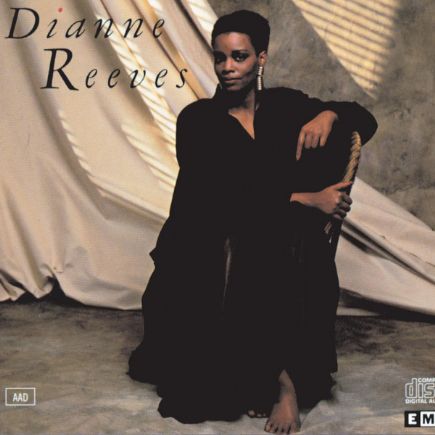Dianne Reeves, la voix profonde du jazz contemporain
Figure majeure du jazz vocal moderne, Dianne Reeves s’impose par la puissance expressive de sa voix, son sens du phrasé et sa capacité rare à conjuguer tradition et modernité. Héritière de Sarah Vaughan et de Carmen McRae, elle fait partie, aux côtés de Dee Dee Bridgewater, Diana Krall et Cassandra Wilson, des grandes dames du jazz de notre temps. Sa carrière, marquée par une remarquable cohérence artistique, illustre la trajectoire d’une musicienne qui a su allier virtuosité, sincérité et exigence.
Née à Detroit et élevée à Denver, Dianne Reeves découvre très tôt la musique à travers sa famille: son oncle, le bassiste Charles Burrell, fut l’un des premiers musiciens afro-américains à intégrer un orchestre symphonique aux États-Unis. En 1971, encore lycéenne, elle chante et joue du piano dans l’orchestre de son école. Lors d’une convention à Chicago, elle est remarquée par le trompettiste Clark Terry, qui l’invite à chanter à ses côtés — un premier pas décisif vers la scène professionnelle.
Peu après, elle s’installe à Los Angeles, où elle enregistre et se produit avec des musiciens de renom tels que Stanley Turrentine, Lenny White et Billy Childs. Avec ce dernier, elle fonde le groupe Night Flight, dont le premier album Welcome to My Love attire l’attention sur la scène californienne. Sa voix chaleureuse et son aisance scénique lui ouvrent rapidement les portes du célèbre beach circuit de la côte Ouest. Dans les années 1980, elle collabore avec Sérgio Mendes et le compositeur Phil Moore, tout en développant une identité artistique de plus en plus affirmée.
En 1986, Dianne Reeves s’installe à New York et enregistre For Every Heart, un album empreint de l’influence d’Harry Belafonte, notamment par son engagement humaniste et son sens du récit. L’année suivante, elle participe au concert Echoes of Ellington à Los Angeles, hommage vibrant à Duke Ellington. Dans le public, Bruce Lundvall, président du label Blue Note Records, est séduit par sa voix et lui propose un contrat.
Son premier album pour le label, Dianne Reeves (1987), avec Herbie Hancock, Freddie Hubbard et Tony Williams, confirme son statut de nouvelle grande voix du jazz et lui vaut une nomination aux Grammy Awards. Suivent I Remember (1991), resté plus de trois mois dans les classements du jazz vocal américain, puis Art and Survival (1994), produit avec Eddie del Barrio, et Quiet After the Storm (1995), à nouveau nommé aux Grammy Awards.
En 2005, elle apparaît dans le film Good Night, and Good Luck de George Clooney, interprétant des standards des années 1950 avec une élégance intemporelle. La bande originale, saluée pour sa sobriété et son intensité, remporte l’année suivante le Grammy Award du meilleur album vocal de jazz.
Dianne Reeves, la voz profunda del jazz contemporáneo
Figura esencial del jazz vocal moderno, Dianne Reeves se impone por la fuerza expresiva de su voz, su dominio del fraseo y su rara capacidad para combinar tradición y modernidad. Heredera de Sarah Vaughan y Carmen McRae, forma parte, junto a Dee Dee Bridgewater, Diana Krall y Cassandra Wilson, de las grandes damas del jazz actual. Su trayectoria, marcada por una coherencia artística ejemplar, refleja la evolución de una intérprete que ha sabido unir virtuosismo, sinceridad y exigencia.
Nacida en Detroit y criada en Denver, Dianne Reeves descubrió la música desde muy joven gracias a su familia: su tío, el bajista Charles Burrell, fue uno de los primeros músicos afroamericanos en integrar una orquesta sinfónica en Estados Unidos. En 1971, aún estudiante de secundaria, cantaba y tocaba el piano en la banda de su escuela. Durante una convención en Chicago, fue descubierta por el trompetista Clark Terry, quien la invitó a cantar con él: un primer paso decisivo hacia su carrera profesional.
Poco después se trasladó a Los Ángeles, donde grabó y actuó con músicos de renombre como Stanley Turrentine, Lenny White y Billy Childs. Con este último fundó el grupo Night Flight, cuyo primer álbum, Welcome to My Love, llamó la atención en la escena californiana. Su voz cálida y su presencia escénica le abrieron rápidamente las puertas del célebre beach circuit de la costa oeste. En los años 1980 colaboró con Sérgio Mendes y el compositor Phil Moore, consolidando una identidad artística cada vez más personal.
En 1986 se instaló en Nueva York y grabó For Every Heart, un álbum influido por Harry Belafonte, especialmente por su compromiso humanista y su sensibilidad narrativa. Al año siguiente participó en el concierto Echoes of Ellington en Los Ángeles, un homenaje vibrante a Duke Ellington. Entre el público se encontraba Bruce Lundvall, presidente del sello Blue Note Records, quien, impresionado por su interpretación, le ofreció un contrato discográfico.
Su primer álbum con el sello, Dianne Reeves (1987), con Herbie Hancock, Freddie Hubbard y Tony Williams, confirmó su condición de gran voz del jazz contemporáneo y le valió una nominación a los Grammy. Le siguieron I Remember (1991), que permaneció más de tres meses en las listas de jazz vocal de Estados Unidos, Art and Survival (1994), producido junto a Eddie del Barrio, y Quiet After the Storm (1995), también nominado a los Grammy.
En 2005 apareció en la película Good Night, and Good Luck de George Clooney, interpretando estándares de los años 1950 con una elegancia atemporal. La banda sonora, aclamada por su sobriedad e intensidad, ganó al año siguiente el Grammy al mejor álbum vocal de jazz.
Dianne Reeves, la voce profonda del jazz contemporaneo
Figura centrale del jazz vocale moderno, Dianne Reeves si distingue per la forza espressiva della sua voce, il senso del fraseggio e la rara capacità di coniugare tradizione e modernità. Erede di Sarah Vaughan e Carmen McRae, appartiene, insieme a Dee Dee Bridgewater, Diana Krall e Cassandra Wilson, al gruppo delle grandi signore del jazz contemporaneo. La sua carriera, segnata da una notevole coerenza artistica, riflette il percorso di un’artista capace di unire virtuosismo, sincerità e rigore.
Nata a Detroit e cresciuta a Denver, Dianne Reeves scoprì la musica fin da bambina grazie alla sua famiglia: lo zio, il contrabbassista Charles Burrell, fu uno dei primi musicisti afroamericani a entrare in un’orchestra sinfonica negli Stati Uniti. Nel 1971, ancora al liceo, cantava e suonava il pianoforte nell’orchestra della sua scuola. Durante una convention a Chicago venne notata dal trombettista Clark Terry, che la invitò a esibirsi con lui — un primo passo decisivo verso la carriera professionale.
Poco dopo si trasferì a Los Angeles, dove registrò e si esibì con musicisti di grande fama come Stanley Turrentine, Lenny White e Billy Childs. Con quest’ultimo fondò il gruppo Night Flight, il cui primo album, Welcome to My Love, attirò l’attenzione della scena californiana. La sua voce calda e la presenza scenica carismatica le aprirono rapidamente le porte del celebre beach circuit della West Coast. Negli anni Ottanta collaborò con Sérgio Mendes e il compositore Phil Moore, consolidando una personalità artistica sempre più definita.
Nel 1986 si trasferì a New York e registrò For Every Heart, un album influenzato da Harry Belafonte, in particolare dal suo impegno umanitario e dal senso narrativo. L’anno seguente partecipò al concerto Echoes of Ellington a Los Angeles, un sentito omaggio a Duke Ellington. Tra il pubblico era presente Bruce Lundvall, presidente della Blue Note Records, che, colpito dalla sua voce, le offrì un contratto discografico.
Il suo primo album per l’etichetta, Dianne Reeves (1987), con Herbie Hancock, Freddie Hubbard e Tony Williams, confermò il suo status di nuova grande voce del jazz e le valse una nomination ai Grammy. Seguirono I Remember (1991), rimasto per oltre tre mesi nelle classifiche del jazz vocale americano, Art and Survival (1994), prodotto insieme a Eddie del Barrio, e Quiet After the Storm (1995), anch’esso candidato ai Grammy.
Nel 2005 apparve nel film Good Night, and Good Luck di George Clooney, interpretando standard degli anni Cinquanta con un’eleganza senza tempo. La colonna sonora, lodata per la sobrietà e l’intensità, vinse l’anno seguente il Grammy per il miglior album vocale jazz.
Dianne Reeves, the deep voice of contemporary jazz
A defining figure of modern vocal jazz, Dianne Reeves stands out for the expressive power of her voice, her refined phrasing, and her rare ability to merge tradition and modernity. Heir to Sarah Vaughan and Carmen McRae, she belongs—alongside Dee Dee Bridgewater, Diana Krall, and Cassandra Wilson—to the pantheon of today’s great jazz vocalists. Her career, marked by remarkable artistic coherence, reflects the path of an artist who has balanced virtuosity, sincerity, and rigor with grace.
Born in Detroit and raised in Denver, Dianne Reeves discovered music early through her family: her uncle, bassist Charles Burrell, was one of the first African American musicians to join a symphony orchestra in the United States. In 1971, while still in high school, she sang and played piano in the school’s band. During a convention in Chicago, she was discovered by trumpeter Clark Terry, who invited her to perform with him—a decisive step toward her professional career.
Soon after, she moved to Los Angeles, where she recorded and performed with acclaimed musicians such as Stanley Turrentine, Lenny White, and Billy Childs. With Childs, she founded the group Night Flight, whose debut album Welcome to My Love attracted attention on the California scene. Her warm voice and natural stage presence quickly earned her recognition on the West Coast’s celebrated beach circuit. During the 1980s, she collaborated with Sérgio Mendes and composer Phil Moore, while refining a strong and independent artistic identity.
In 1986, Reeves relocated to New York and recorded For Every Heart, an album influenced by Harry Belafonte’s humanism and storytelling spirit. The following year, she took part in Echoes of Ellington in Los Angeles, a moving tribute to Duke Ellington. Among the audience was Bruce Lundvall, president of Blue Note Records, who was captivated by her performance and offered her a recording contract.
Her first album for the label, Dianne Reeves (1987), featuring Herbie Hancock, Freddie Hubbard, and Tony Williams, confirmed her as one of jazz’s leading voices and earned a Grammy nomination. Subsequent releases—I Remember (1991), which remained on the U.S. vocal jazz charts for over three months, Art and Survival (1994) with Eddie del Barrio, and Quiet After the Storm (1995)—further solidified her reputation, with the latter again earning a Grammy nomination.
In 2005, Reeves appeared in George Clooney’s film Good Night, and Good Luck, performing 1950s standards with timeless elegance. The soundtrack, praised for its restraint and emotional depth, won the following year’s Grammy Award for Best Jazz Vocal Album.


